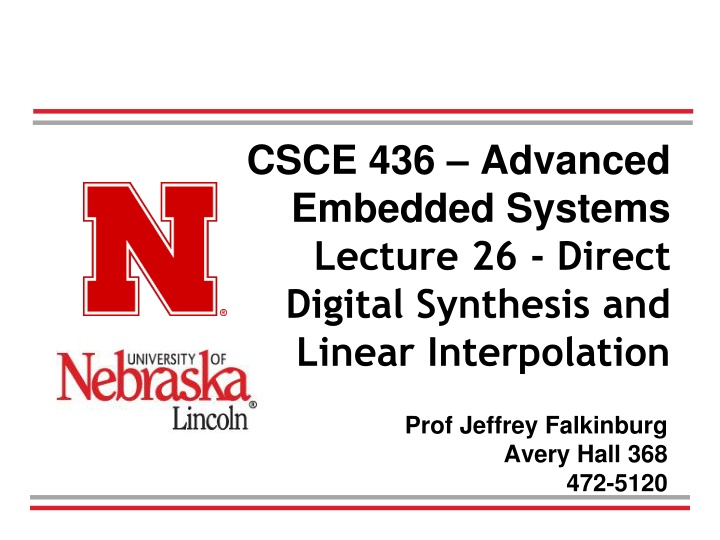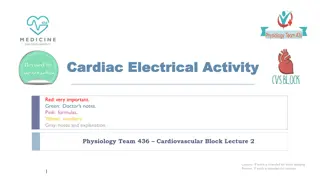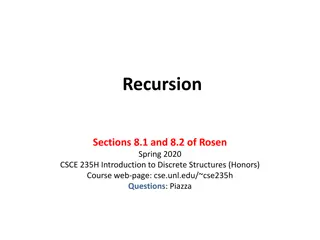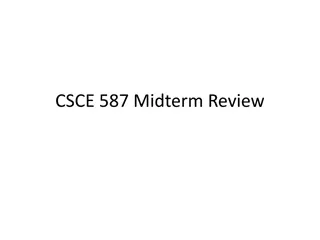
Advanced Embedded Systems Lecture: Direct Digital Synthesis and Interpolation
Learn about direct digital synthesis, linear interpolation, and look-up tables in advanced embedded systems. Discover how interpolation can help in creating missing data efficiently.
Download Presentation

Please find below an Image/Link to download the presentation.
The content on the website is provided AS IS for your information and personal use only. It may not be sold, licensed, or shared on other websites without obtaining consent from the author. If you encounter any issues during the download, it is possible that the publisher has removed the file from their server.
You are allowed to download the files provided on this website for personal or commercial use, subject to the condition that they are used lawfully. All files are the property of their respective owners.
The content on the website is provided AS IS for your information and personal use only. It may not be sold, licensed, or shared on other websites without obtaining consent from the author.
E N D
Presentation Transcript
CSCE 436 Advanced Embedded Systems Lecture 26 - Direct Digital Synthesis and Linear Interpolation Prof Jeffrey Falkinburg Avery Hall 368 472-5120
Lesson Outline Time Logs! Lab 3 O Scope Control Lab Report Due COB Today Project Proposals Due BOC LSN 27 Direct Digital Synthesis 2 I n t e g r i t y - S e r v i c e - E x c e l l e n c e
LUT Look Up Table 3 I n t e g r i t y - S e r v i c e - E x c e l l e n c e
LUT Look Up Table Let's say that you wanted to compute the square root of an value using the microBlaze. If you were lucky enough to have a compiler which provided this function you could just use the math library functions. If on the other hand, you did not have the use of such a library, you would have to figure out a way to compute the square root. 4 I n t e g r i t y - S e r v i c e - E x c e l l e n c e
LUT Look Up Table There are many ways to compute the SQRT Function: Crack open a book to find a mathematical expression Unfortunately this typically leads to timely computations You could enumerate an every possible value of x and its square root. We could then look-up a SQRT in the table, by going to the row corresponding to the x and retrieving its value. This approach seems silly since it would use a lot of space We could reduce this space by eliminating entries We save space at the expense of introducing errors. If you wanted the SQRT for x and its entry wasn t in the table you would have to use the closest x in the table 5 I n t e g r i t y - S e r v i c e - E x c e l l e n c e
LUT Look Up Table A good compromise among all three of these design constraints: Space Time Error Is to use Interpolation in a partial Look-Up-Table (LUT) 6 I n t e g r i t y - S e r v i c e - E x c e l l e n c e
Interpolation "Interpolation is a mathematical method of creating missing data. ... There are many methods of interpolation, but one simple method would be to generate a new value by using the average of the value of the two values on either side of the one to be created. This average is also referred to as linear interpolation. For example if you have a value of x which is 1/2 way between 0 and 4 then you assume that the SQRT is 1/2 between 0 and 2. 7 I n t e g r i t y - S e r v i c e - E x c e l l e n c e
Linear Interpolation We know that if f(x)=y and f(x+4)=z then we estimate the intermediate values of f(x+1), f(x+2), and f(x+3) by drawing a straight line between y and z and using the points on this line to estimate the function between x and x+4. For example, let: F(8)=2.8284 and F(12)=3.4641 then F(9) = 2.8284 + 1/4(3.4641-2.8284) = 2.987 F(10) = 2.8284 + 2/4(3.4641-2.8284) = 3.146 F(11) = 2.8284 + 3/4(3.4641-2.8284) = 3.305 We understand that this is an approximation and consequently we will have error, but sometimes close is better than exact in embedded computing especially when time is of the essence. 8 I n t e g r i t y - S e r v i c e - E x c e l l e n c e
Linear Interpolation //---------------------------------------------- // A code chunk to perform linear // interpolation of some unknown fnc at // x+i where i is between 0 and 4 // inclusive. You are given that // f(x)=y // You are given i, please return f(x+i) //---------------------------------------------- delta = (z-y)>>2; f = y + delta*i; It would be better to do the division by 4 (shift right by 2-bits) after the multiplication of delta*i because the difference (z-y) might be small and the division may result in a 0 value. f(x+4)=z 9 I n t e g r i t y - S e r v i c e - E x c e l l e n c e
Square Root Interpolation 4 Point LUT index 0 1 2 3 4 x 0 4 8 sqrt(x) 0 2 2.828427 3.464102 4 12 16 True and discrete SQRT values 5 4 3 SQRT(x) SQRT base 2 1 0 0 1 2 3 4 5 6 7 8 9 101112131415 x 10 I n t e g r i t y - S e r v i c e - E x c e l l e n c e
Square Root Interpolation Equation Let's consider how to use interpolation to find a better value for the SQRT(9). Clearly, the SQRT will be between SQRT(8) and SQRT(12). How much between? Well 1/4 of the way because 9 is a 1/4 of the way between 9 and 12. Have the class write an equation describing SQRT(9) in terms of SQRT(12) and SQRT(8). SQRT(9) = SQRT(8) + 1/4*(SQRT(12)-SQRT(8)) 11 I n t e g r i t y - S e r v i c e - E x c e l l e n c e
Square Root Interpolation Equation Now write the equation replacing the 1/4 by a statement using 9,8, and 12. SQRT(9) = SQRT(8) + (9-8)/(12-8)*(SQRT(12)-SQRT(8)) 12 I n t e g r i t y - S e r v i c e - E x c e l l e n c e
Square Root Interpolation Spreadsheet Now divide the class into 16 sections to compute all the values of SQRT for 0-15. Compare these to the excel spreadsheet (4pt SQRT tab). In this spreadsheet, I've broken the computation down so that you can see what the individual parts are doing see next slide 13 I n t e g r i t y - S e r v i c e - E x c e l l e n c e
Square Root Interpolation Spreadsheet SQRT(9) = SQRT(8) + (9-8)/(12-8)*(SQRT(12)-SQRT(8)) base - this is the SQRT(8) term in the equation above. It represents the base value from which we will interpolate. offset - this is the (9-8)/(12-8) term in the equation above. It represents how much offset you are into the interval. delta - this is the SQRT(12)-SQRT(8) term in the equation above. Its how much range the function covers between the two values in the LUT. base + offset*delta - this is the value of the SQRT function for the input given in the "x" column. error(x) - this is the absolute values of the difference between the linear interpolation value and the true value of the SQRT function. 14 I n t e g r i t y - S e r v i c e - E x c e l l e n c e
Square Root Interpolation Spreadsheet - 4 Point LUT X SQRT(X) base offset delta base + offset*delta error(x) 0 1 2 1.414214 3 1.732051 4 5 2.236068 6 2.44949 7 2.645751 8 2.828427 2.828427 9 3 2.828427 10 3.162278 2.828427 11 3.316625 2.828427 12 3.464102 3.464102 13 3.605551 3.464102 14 3.741657 3.464102 15 3.872983 3.464102 0 1 0 0 0 0 2 2 2 2 0 2 2 2 2 0 0 0.25 0.5 0.75 0.5 0.5 1 0.414214 1.5 0.232051 2 2 0 0.828427 0.25 0.828427 0.5 0.828427 0.75 0.828427 0 0.635674 0.25 0.635674 0.5 0.635674 0.75 0.635674 0 0.535898 0.25 0.535898 0.5 0.535898 0.75 0.535898 0 2.207106781 0.028961 2.414213562 0.035276 2.621320344 0.024431 2.828427125 2.987345747 0.012654 3.14626437 0.016013 3.305182993 0.011442 3.464101615 3.598076211 0.007475 3.732050808 0.009607 3.866025404 0.006958 0 0 15 I n t e g r i t y - S e r v i c e - E x c e l l e n c e
Square Root Interpolation 4 Point LUT True and Apprx SQRT 4.5 4 3.5 3 SQRT(x) 2.5 SQRT(X) base + offset*delta 2 1.5 1 0.5 error(x) 0 0.6 0.5 x 0.4 0.3 0.2 0.1 0 0 5 10 15 20 16 I n t e g r i t y - S e r v i c e - E x c e l l e n c e
Square Root Interpolation 4 Point LUT //---------------------------------------------- // Fnc SQRT // In A 4-bit integer // Out An approximate SQRT // Pur This function computes a linear interpolated value for the SQRT // function. There are some significant data type issues that will have to // be resolved - note the use of "type" in the function is a place-holder. //---------------------------------------------- fixed SQRT(int4 x) { fixed lut[5] = {0, 2, 2.828427125, 3.464101615, 4}; int8 index; fixed base; index = x >> 2; base = lut[index]; offset = (x & 0x03)>>2; delta = lut[x+1] - lut[x]; return(base + offset*delta); } // end SQRT // We are looking at sets of 4 points // Get the base value to start interpolation // The proportion into the interval - PROBLEM // The difference between consecutive SQRTs 17 I n t e g r i t y - S e r v i c e - E x c e l l e n c e
Square Root Interpolation Data Type //---------------------------------------------- // Fnc SQRT // In A 4-bit integer // Out An approximate SQRT 8-bit fixed point with decimal at 6th bit. // Pur This function computes a linearly Interpolated value for the SQRT. The // 5th entry in the lut is an approximation to 4. //---------------------------------------------- int8 SQRT(int8 x) { int8 lut[5] = {0x00, 0x80, 0xB5, 0xDE, 0xFF}; int8 index; fixed base; index = x >> 2; base = lut[index]; offset = (x & 0x03) delta = lut[index+1] - lut[index]; return(base + offset*delta)>>2; } // end SQRT 18 I n t e g r i t y - S e r v i c e - E x c e l l e n c e
Square Root Interpolation LUT index 0 1 2 3 4 x 0 4 8 sqrt(x) 0 2 2.828427 3.464102 4 sqrt * 2^6 Trunc Down 2.6 Binary 2.6 Hex 0 0 128 128 181.0193 181 221.7025 221 256 255 00.000000 10.000000 10.110101 11.011101 11.111111 00 80 B5 DD FF 12 16 True and discrete SQRT values 5 4 3 SQRT(x) SQRT base 2 1 0 0 1 2 3 4 5 6 7 8 9 101112131415 x 19 I n t e g r i t y - S e r v i c e - E x c e l l e n c e
Square Root Interpolation 8 Point LUT LUT 10.6 Binary index 0 1 2 3 4 5 6 7 8 x 0 16 32 48 64 80 96 112 128 sqrt(x) 0 4 5.656854 6.928203 8 8.944272 9.797959 10.58301 11.31371 sqrt * 2^6 0 256 362.0387 443.405 512 572.4334 627.0694 677.3123 724.0773 Trunc down Upper 10-Bits Lower 6-Bits 0 0000000000 256 0000000100 362 0000000101 443 0000000110 512 0000001000 572 0000001000 627 0000001001 677 0000001010 724 0000001011 000000 000000 101010 111011 000000 111100 110011 100101 010100 20 I n t e g r i t y - S e r v i c e - E x c e l l e n c e
Square Root Interpolation 8 Point LUT Real and Approx SQRT 12 10 8 SQRT(X) SQRT 6 4 LUT(X) 2 0 x 21 I n t e g r i t y - S e r v i c e - E x c e l l e n c e
Square Root Interpolation 8 Point LUT Error of 8 point SQRT LUT 1 0.1 error(x) 0.01 0.001 x 22 I n t e g r i t y - S e r v i c e - E x c e l l e n c e
Practice Base 127 175 Delta Offset*Delta Base + Offset*Delta 127+0 = 127 175+28 = 203 0 1 2 3 4 5 6 7 8 9 127 175 216 244 253 244 216 175 127 78 37 Time Index 175-127 = 48 = 110000 216-175 = 41 = 101001 0.0000*110000 = 00000.0000 0.1011*101001 = 11100.0011 0 1 2 3 4 5 6 7 8 9 0000.0000 0001.1011 10 11 12 13 14 15 9 0 9 10 11 12 13 14 36 78 23 I n t e g r i t y - S e r v i c e - E x c e l l e n c e
Practice Base 127 175 Delta Offset*Delta Base + Offset*Delta 127+0 = 127 175+28 = 203 0 1 2 3 4 5 6 7 8 9 127 175 216 244 253 244 216 175 127 78 37 Time Index 175-127 = 48 = 110000 216-175 = 41 = 101001 0.0000*110000 = 00000.0000 0.1011*101001 = 11100.0011 0 1 2 3 4 5 6 7 8 9 0000.0000 0001.1011 10 11 12 13 14 15 9 0 9 10 11 12 13 14 36 78 24 I n t e g r i t y - S e r v i c e - E x c e l l e n c e
















